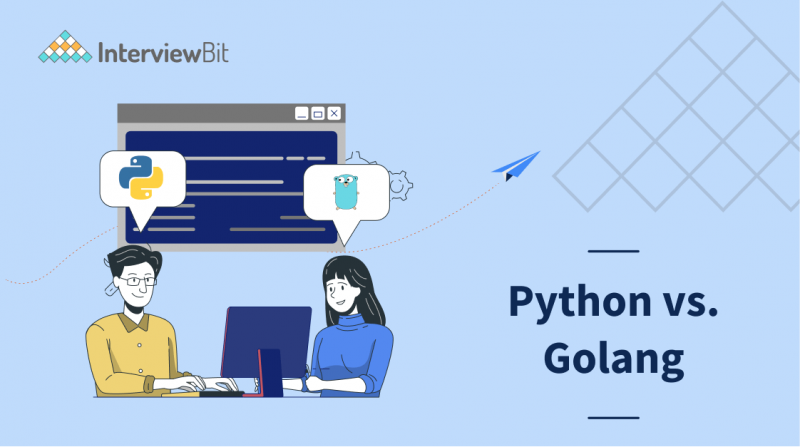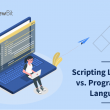The web development industry has been in the spotlight right from the inception of the Internet, and this industry would be at the center of attraction for years to come. Nevertheless, the technologies that run this industry are constantly changing. Now, there are several programming languages available to design websites. Python and Golang are two the advanced web languages. In today’s world, the ability to draft any code is a large advantage, but the biggest concern coders face is not knowing which coding language to start learning. There are multiple languages for every purpose you could think of. Of those common coding languages, developers often face an intensive battle of Golang vs Python. (Go is the official name but the website is Golang.org, so developers ideally refer to it as either interchangeably.)
Apparently, the two are notably dissimilar. Python was developed in 1991, an oldster in coding years, whereas Go was first published in the year 2012 by Google, a relative newcomer among its peers. Programmers at Google launched Golang to expedite productivity and faults in the development process occurring with other programming languages. Like we all know, Golang is a more recently developed language than Python. Golang is quite popular for its speed, whereas Python is regarded to be a slower language. Python is resourceful, while Go is more stringent in syntax and formatting. Nevertheless, they are both considered as answers to a lot of conventional coding questions like which is the most suitable language to learn as a beginner? Which language is best to obtain a computer programming job? Which coding language is most helpful?
When we talk about Python vs Golang in terms of its scope, they can both be used in various realms. Yet, experts recommend Python is far more versatile than Golang. Golang is a language like Python with comprehensive use. Let us take a look at an intense comparison between these two languages in this article.
Confused about your next job?
What is Golang?
Golang is a procedural, compiled, and statically typed programming language devised by Google. It was developed in 2007 by Ken Thompson, Robert Griesemer, and Rob Pike at Google but launched in the year 2009 as an open-source programming language. Programs are assembled with the help of packages, for effective management of dependencies. Golang also helps environment adopting patterns alike to dynamic languages. For example type inference (y:= 0 is a valid declaration of a variable y of type float).
Go was basically developed for programs related to networking and infrastructure. It was designed to replace conventional high-performance server-side languages like C++ and Java. Now, Go is used for different kinds of applications:
Go is the most sought-after for cloud-based or server-side applications.
DevOps and site reliability automation are also recommended ways to work with Golang.
Several command-line tools are drafted in Go.
Go is practiced in the world of data science and artificial intelligence.
Many employ Golang from micro-controller programming, games, and robotics.
Nevertheless, Go is really popular when it comes to infrastructure. A few of the most common infrastructure tools are written in Go — including Kubernetes, Prometheus, and Docker.
Features of Golang
- Simplicity: Golang makes reliability, readability and maintainability it’s main priority and doesn’t compete to prove itself to be feature-rich The developers of Golang incorporate only those traits to the language which are important and do not make the language complex by adding a number of things. You will understand how simple Golang is when you will start using it. Also, if you are checking someone else’s Golang code, no matter how big the code base is, each and every line will be very much simple and understandable to you.
- Powerful Standard Library: Golang has a strong set of library packages, making it simple for you to compose your code. Though its library is not as diverse as Python or Java, it has all the fundamental stuff.
- Concurrency in Golang: Another incredible feature that has made Golang popular is its concurrency feature. Golang offers Goroutines and channels to deal with concurrency. Concurrency effectively makes use of Multi-processor architecture. Concurrency also aids in the more reliable scaling of large applications. Some notable cases of Projects written in go are — Docker, Hugo, Kubernetes, and Dropbox.
- Web Application Building: Golang has garnered attention as a web application building language owing to its easy constructs and more agile execution speed. There are several tutorials available on the internet, you can just start with anything.
- Testing Support: Golang offers a way to test the package that you formulate. With the help of the “go test” command you will be able to test your code composed in “*_test.go” files. To make any program stable, testing is a necessity, you should add a test function along with the actual function every time you draft some code.
- Speed of Compilation: Well, this is the scenario where Golang wins the hearts of many users as its speed of compilation and completion is much more solid than many well-known programming languages. Golang is readily parsable without a symbol table. Keeping in mind the speed of compilation and execution in mind the design of Golang and its compiler was done.
What is Python?
Python is a general-purpose, high-end, and very sought-after programming language. Python programming language is used in Machine Learning applications, data science, web development, alongside all modern technology in Software Industry. Python is an easy-to-learn syntax that enhances readability and lessens the cost of program maintenance. Python supports packages and supports, which promotes program modularity and reuse of code. The Python interpreter and the comprehensive standard library are accessible in source or binary form without charge for all significant platforms and can be distributed freely.
Below mentioned are a few facts about Python Programming Language:
- Currently, Python is the most extensively used versatile, high-level programming language.
- Python enables programming in object-oriented and procedural paradigms.
- Python programs are comparatively smaller than other programming languages like Java. Developers have to type moderately less and the indentation requirement of the language makes them readable all the time.
- Almost all tech-giant companies like Google, Facebook, Dropbox use Python language.
- The biggest plus point of Python is the huge collection of standard libraries which can be used for the following:
- Machine Learning
- GUI Applications (including Kivy, PyQt Tkinter, etc. )
- Web frameworks such as Django (used by YouTube, Instagram, Dropbox)
- Image processing (like OpenCV, Pillow)
- Web scraping (including BeautifulSoup, Scrapy, Selenium)
- Test frameworks
- Multimedia
- Scientific computing
- Text processing
Features of Python
- Easy to code: Python is a high-end programming language. One can easily learn Python language as compared to other languages. Python is also very simple to code in the Python language and any person can learn the basics of python in a few hours or days. It is also a very programmer-friendly language.
- Free and Open Source: Python language is available on the official website and you can download it by clicking on the Download Python keyword. As it is open-source, it means that source code is also available to the public. So, you can download it, use it, and share it is as well.
- Object-Oriented Language: Object-Oriented programming is one of the essential features of python. Python backs the concepts of classes, objects encapsulation, and object-oriented language.
- GUI Programming Support: By using modules like PyQt5, PyQt4, wxPython, or Tk in python, Graphical User Interfaces (GUI) can be made.
PyQt5 is the most common option for generating graphical apps with Python. - High-Level and Interpreted Language: Python is a high-end language. When we formulate programs in Python, there is no need of remembering the system architecture, neither do we need to manage the memory. Python is regarded as an Interpreted Language as Python code is run line by line at a time. Like other programming languages, there is no requirement to compile python code, making it easy to debug our code. Python’s source code is transformed into an immediate form called bytecode.
- Extensible feature and Portable language: Python is an Extensible language. We can formulate some Python code into C or C++ language furthermore, we can compile that code in C/C++ language.
Python is also a very portable language. Like, if we own python code for windows and if we want to run this code on platforms like Unix, Linux, and Mac then there is no need to change it, we can deploy this code on any platform.
Key Differences
Below mentioned are the key differences between Python and Golang:
- As Python is a scripting language, it has to be interpreted, while Golang is quicker most of the time as it does not have to count on anything at runtime.
- Python is an ideal language that comes equipped with an easy-to-understand syntax, making it more readable and flexible. Golang is also in the prime league when it comes to clear syntax, which holds zero unnecessary components.
- Python doesn’t come with a built-in concurrency mechanism, whereas Go is packed with a built-in concurrency mechanism.
- Talking about safety, Python is a well-typed compiled language thereby incorporating a layer of security, while Golang is very decent because every variable should have a type connected with it. It implies a programmer cannot give away the details, which will further lead to flaws.
- Python is less verbose compared to Go to accomplish the same functionality.
- Python comes with dozens of libraries as opposed to Go, but gradually Go is also improving in this area.
- Python still earns the upper hand when it comes to syntax, making it very user-friendly.
- Python is considered the best when you have to solve data science problems, while Go is best suited for system programming.
- Python is a dynamically typed language, while Golang is a statically typed language, which helps you to detect flaws at compile-time, further reducing serious glitches later in the production.
- Python is the best choice for basic programming. Python can become complex if one prefers to build complicated systems. But with Go, the same task can be executed quickly without getting into the subtleties of programming language.
- Python is more compact than Golang.
Golang vs Python: Full Comparison

| GOLANG | PYTHON |
| Golang is a procedural programming language that is on concurrent programming. | Python is a high-end programming language that is based on object-oriented programming |
| Exceptions are not supported by Golang, instead of the exception, it has error. | Python support exceptions. |
| Object-oriented programming is not supported by Golang. Therefore, it does not have classes and objects. | Python has class and objects. |
| Golang does not support inheritance. | It supports inheritance. |
| It supports channel and Goroutines | Python does not support Goroutines and channels. |
| It supports interfaces. | It does not support interfaces. |
| Golang is a statically typed language. Hence, it employs a compiler. | Python is a dynamically typed language. Therefore, it employs an interpreter. |
| Go is more verbose | Python is less verbose |
| Golang fully supports concurrency | Python does not come with any in-built concurrency mechanism. |
| Golang is good for system programming | Python is best for computing and data analysis |
Golang vs Python – Which is better?
When productivity is taken into consideration, Golang is the most suitable language to become a more productive programmer. The syntax is limited and the libraries are much less heavy, it is quicker to get work done in fewer lines of code as there is less code available to write. Python has the edge in terms of versatility solely because of the number of libraries and the range of syntax. Nevertheless, versatility also comes at a price, and that price is productivity. In this battle of Python vs Golang which is the most productive language? Golang wins because it is designed to be more productive, simpler to debug, and most importantly, it’s easier to read.
Python is unquestionably the most common choice for developers who want to formulate a machine learning model. The reason is Python is the first choice for machine learning and that it’s the home of TensorFlow, a deep learning framework within Python. While learning the basics of computer science like algorithms and data structures, pseudo-code is frequently used. Knowing a programming language like Python, which almost resembles to pseudo-code, is an added benefit that makes learning easier. On the other hand, Golang is super fast, effortless to write, comes along with Go doc which creates documentation automatically, making the life of the programmer easier.
Conclusion
To sum it up, both Python and Golang have their own share of benefits, depending on the programmer’s skill and capability to gauge the real-world requirement. Both Python and Golang are very much and clear when it comes to syntax and lessen the task of the developer up to a greater extent. Picking the appropriate language for your coding can indicate the difference between an effective program and a program that needs a lot of maintenance. If your primary purpose of developing a tool is speed and scalability, Golang is your perfect choice. Golang is the language that comes close to the speed of C/C++, at the same time it is very easy to use, and also you can get rid of manual memory management.
But, if you want to generate scripts and tools that run effectively while promoting readability across teams, Python can be your best option. The language reads like regular English and can be well understood by even developers who haven’t had experience with Python before.
By default, the indented blocks make the code look neat, and support clean coding. And the various libraries available for free reduce the number of lines you have to use within your code.
FAQs
- Should I learn Go or Python?
Answer: Python supports concurrent processes and threads, it is a little complicated to use compared to Go, and the performance isn’t as great. If you are a student and keen to learn something that will get you a high package salary, opt for Python. If you are already working somewhere as a software engineer and want to enhance your skills, want to go for something different for the future, master Go. If you want to learn something quick and simple, go for Python. Something challenging but fun, Golang.
- Is Golang going to replace Python soon?
Answer: Python and Golang are both fascinating languages, but it is not really possible that Go will replace Python since they are very distinctive languages with diverse uses.
- Is Go harder than Python?
Answer: Python is easy. Though Python does not manage to be both quick and simple, but it is not slow and challenging either. It is a comparatively simple language, only less accessible than Go is. The free libraries of Python and commonly used tutorials make it effortless to learn. The syntax is also simple to learn in Python. To expedite your learning journey, considering a Python course could be immensely beneficial.
- Does Golang have a future?
Answer: Absolutely, Go has a future, it has skyrocketed in popularity recently and eventually it will become a top-tier programming language soon. In a nutshell, we must agree that Golang is a programming language of the future both in terms of career growth and the development process. There is no doubt that Golang is the programming language of the future.







 Join WhatsApp Group
Join WhatsApp Group


